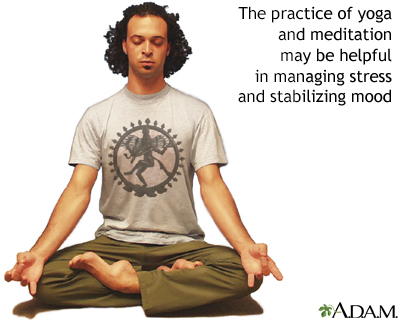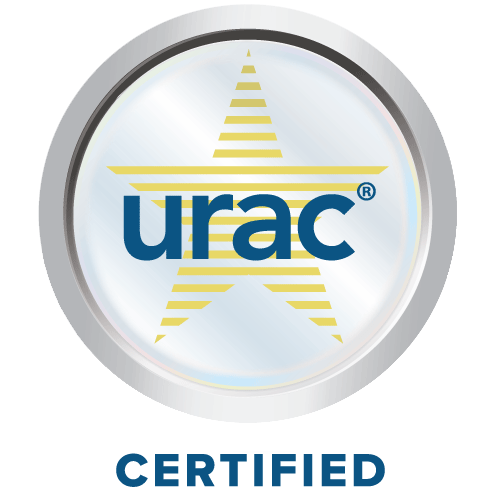Relaxation techniques for stress
Relaxation response techniques; Relaxation exercises
Images

Description
Chronic stress can be bad for your body and mind. It can put you at risk for health problems such as high blood pressure, stomachaches, headaches, anxiety, and depression. Using relaxation techniques can help you feel calm. These exercises can also help you manage stress and ease the effects of stress on your body.
How Relaxation Helps
When you feel stress, your body responds by releasing hormones that increase your blood pressure and raise your heart rate. This is called the stress response.
Relaxation techniques can help your body relax and lower your blood pressure and heart rate. This is called a relaxation response. There are several techniques you can try. See which ones work best for you.
Deep Breathing
One of the simplest ways to relax is by practicing deep breathing. You can do deep breathing almost anywhere.
- Sit still or lie down and place one hand on your stomach. Put your other hand over your heart.
- Inhale slowly until you feel your stomach rise.
- Hold your breath for a moment.
- Exhale slowly, feeling your stomach fall.
There are also many other types of breathing techniques you can learn. In many cases, you will not need much instruction to do them on your own.
Meditation
Meditation involves focusing your attention to help you feel more relaxed. Practicing meditation may help you react in a calmer way to your emotions and thoughts, including those that cause stress. Meditation has been practiced for thousands of years, and there are several different styles.
Most types of meditation usually include:
- Focused attention. You might focus on your breath, an object, or a set of words.
- Quiet. Most meditation is done in a quiet area to limit distractions.
- Body position. Most people think meditation is done while sitting, but it can also be done lying down, walking, or standing.
- An open attitude. This means that you stay open to thoughts that come into your mind during meditation. Instead of judging these thoughts, you let them go by bringing your attention back to your focus.
- Relaxed breathing. During meditation, you breathe slowly and calmly. This also helps you relax.
Biofeedback
Biofeedback teaches you how to control some of your body's functions, such as your heart rate or certain muscles.
In a typical session, a biofeedback therapist attaches sensors to different areas of your body. These sensors measure one or more of your skin temperature or sweating, brain waves, breathing, and muscle activity. You can see these readings on a monitor. Then you practice changing your thoughts, behaviors, or emotions to help control your body's responses. Over time, you can learn to change them without using the monitor.
Progressive Relaxation
This is another simple technique that you can do almost anywhere. Starting with your toes and feet, focus on tightening your muscles for a few moments and then releasing them. Continue with this process, working your way up your body, focusing on one group of muscles at a time.
Yoga
Yoga is an ancient practice rooted in Indian philosophy. The practice of yoga combines postures or movements with focused breathing and meditation. The postures are meant to increase strength and flexibility. Postures range from simple poses lying on the floor to more complex poses that may require years of practice. You can modify most yoga postures based on your own ability.
There are many different styles of yoga that range from slow to vigorous. If you are thinking about starting yoga, look for a teacher who can help you practice safely. Make sure to tell your teacher about any recent or past injuries.
Tai Chi
Tai chi was first practiced in ancient China for self-defense. Today, it is used mainly to improve health. It is a low-impact, gentle type of exercise that is safe for people of all ages.
There are many styles of tai chi, but all involve the same basic principles:
- Slow, relaxed movements. The movements in tai chi are slow, but your body is always moving.
- Careful postures. You hold specific postures as you move your body.
- Concentration. You are encouraged to put aside distracting thoughts while you practice.
- Focused breathing. During tai chi, your breathing should be relaxed and deep.
If you are interested in tai chi for stress relief, you may want to start with a class. For many people, it is the easiest way to learn the proper movements. You can also find books and videos about tai chi.
For More Information
You can learn more about any of these techniques through local classes, books, videos, or online.
References
Minichiello VJ. Relaxation techniques. In: Rakel D, Minichiello VJ eds. Integrative Medicine. 5th ed. Philadelphia, PA: Elsevier; 2023:chap 91.
National Center for Complementary and Integrative Health website. 5 things to know about relaxation techniques for stress. www.nccih.nih.gov/health/tips/things-to-know-about-relaxation-techniques-for-stress. Updated September 23, 2024. Accessed September 23, 2024.
National Center for Complementary and Integrative Health website. Meditation and mindfulness: effectiveness and safety. www.nccih.nih.gov/health/meditation-and-mindfulness-effectiveness-and-safety. Updated June 2022. Accessed September 23, 2024.
National Center for Complementary and Integrative Health website. Relaxation techniques: what you need to know. www.nccih.nih.gov/health/relaxation-techniques-what-you-need-to-know. Updated June 2021. Accessed September 23, 2024.
National Center for Complementary and Integrative Health website. Tai Chi: what you need to know. www.nccih.nih.gov/health/tai-chi-what-you-need-to-know. Updated December 2023. Accessed September 23, 2024.
National Center for Complementary and Integrative Health website. Yoga: effectiveness and safety. www.nccih.nih.gov/health/yoga-effectiveness-and-safety. Updated August 2023. Accessed September 23, 2024.
BACK TO TOPReview Date: 9/15/2024
Reviewed By: Jacob Berman, MD, MPH, Clinical Assistant Professor of Medicine, Division of General Internal Medicine, University of Washington School of Medicine, Seattle, WA. Also reviewed by David C. Dugdale, MD, Medical Director, Brenda Conaway, Editorial Director, and the A.D.A.M. Editorial team.

Health Content Provider
06/01/2025
|
A.D.A.M., Inc. is accredited by URAC, for Health Content Provider (www.urac.org). URAC's accreditation program is an independent audit to verify that A.D.A.M. follows rigorous standards of quality and accountability. A.D.A.M. is among the first to achieve this important distinction for online health information and services. Learn more about A.D.A.M.'s editorial policy, editorial process and privacy policy. A.D.A.M. is also a founding member of Hi-Ethics. This site complied with the HONcode standard for trustworthy health information from 1995 to 2022, after which HON (Health On the Net, a not-for-profit organization that promoted transparent and reliable health information online) was discontinued. |
The information provided herein should not be used during any medical emergency or for the diagnosis or treatment of any medical condition. A licensed medical professional should be consulted for diagnosis and treatment of any and all medical conditions. Links to other sites are provided for information only -- they do not constitute endorsements of those other sites. © 1997- 2025 A.D.A.M., a business unit of Ebix, Inc. Any duplication or distribution of the information contained herein is strictly prohibited.
